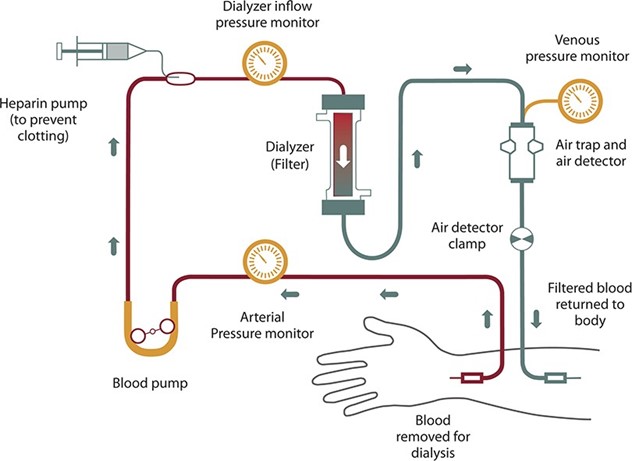A nurse is providing discharge teaching to a client who has a new arteriovenous fistula in the right forearm. Which of the following manifestations should the nurse include in the teaching as a possible indication of venous insufficiency?
Cold and numb sensation distal to the fistula site
A raised red rash around the fistula site
Pain in the right arm proximal to the fistula site
Foul-smelling drainage from the fistula site
The Correct Answer is A
Choice A: Cold and numb sensation distal to the fistula site is a possible indication of venous insufficiency. Venous insufficiency is a condition in which the veins have difficulty returning blood from the limbs to the heart, resulting in blood pooling and reduced perfusion. A new arteriovenous fistula can cause increased blood flow through the artery and decreased blood flow through the vein, leading to venous insufficiency. This can manifest as coldness, numbness, tingling, or cyanosis in the fingers or hand below the fistula site.
Choice B: A raised red rash around the fistula site is not a possible indication of venous insufficiency. A raised red rash around the fistula site can indicate an allergic reaction, an infection, or an inflammation of the skin or subcutaneous tissue. The nurse should assess the rash for size, shape, color, texture, temperature, and drainage, and report any signs of infection or inflammation, such as fever, pus, or swelling.
Choice C: Pain in the right arm proximal to the fistula site is not a possible indication of venous insufficiency. Pain in the right arm proximal to the fistula site can indicate arterial insufficiency, which is a condition in which the arteries have difficulty delivering oxygen-rich blood to the tissues, resulting in ischemia and necrosis. Arterial insufficiency can be caused by atherosclerosis, thrombosis, embolism, or vasospasm. The nurse should assess the pain for location, intensity, duration, frequency, and quality, and report any signs of ischemia or necrosis, such as pallor, coolness, weak pulses, or ulceration.
Choice D: Foul-smelling drainage from the fistula site is not a possible indication of venous insufficiency. Foul-smelling drainage from the fistula site can indicate an infection of the fistula or surrounding tissue. The nurse should assess the drainage for color, odor, amount, and consistency, and report any signs of infection or sepsis, such as fever, chills, malaise, or hypotension.
Nursing Test Bank
Naxlex Comprehensive Predictor Exams
Related Questions
Correct Answer is B
Explanation
Choice a) is incorrect because calcium levels are not directly affected by hemodialysis. Calcium is a mineral that is important for bone health, blood clotting, and muscle contraction. Hemodialysis does not remove calcium from the blood, but it may cause low calcium levels if the dialysate fluid has a lower concentration of calcium than the blood.
Choice b) is correct because potassium levels are decreased by hemodialysis. Potassium is an electrolyte that is essential for nerve and muscle function, especially the heart. Hemodialysis removes excess potassium from the blood, which can build up in people with kidney failure and cause irregular heartbeats, muscle weakness, or even cardiac arrest.
Choice c) is incorrect because protein levels are not decreased by hemodialysis. Protein is a macromolecule that is composed of amino acids and performs various functions in the body, such as building and repairing tissues, transporting substances, and regulating processes. Hemodialysis does not remove protein from the blood, but it may cause low protein levels if the client has a poor diet or loses protein through other means, such as urine or wounds.
Choice d) is incorrect because RBC count is not decreased by hemodialysis. RBCs are red blood cells that carry oxygen throughout the body. Hemodialysis does not remove RBCs from the blood, but it may cause low RBC count if the client has anemia, which is a common complication of kidney failure. Anemia can be caused by reduced production of erythropoietin (a hormone that stimulates RBC production), iron deficiency, or blood loss.

Correct Answer is C
Explanation
Choice A Reason: This is incorrect because the client's best motor response is 5, which means he can localize pain, not follow commands.
Choice B Reason: This is incorrect because the client's eye opening response is 3, which means he opens his eyes to pain, not to speech.
Choice C Reason: This is correct because the client's GCS score is 13, which indicates a severe impairment of consciousness. The GCS is a tool used to assess the level of consciousness of a person who has a head injury. The GCS score ranges from 3 to 15, with lower scores indicating lower levels of consciousness. A GCS score of 8 or less indicates coma. The client's GCS score is 3 + 5 + 5 = 13, which is above the coma threshold, but still indicates a severe impairment of consciousness. The other choices are not consistent with the client's GCS score.
Choice D Reason: This is incorrect because the client's best verbal response is 5, which means he can orient himself to person, place, and time, not that he is unable to make vocal sounds.
Whether you are a student looking to ace your exams or a practicing nurse seeking to enhance your expertise , our nursing education contents will empower you with the confidence and competence to make a difference in the lives of patients and become a respected leader in the healthcare field.
Visit Naxlex, invest in your future and unlock endless possibilities with our unparalleled nursing education contents today
Report Wrong Answer on the Current Question
Do you disagree with the answer? If yes, what is your expected answer? Explain.
Kindly be descriptive with the issue you are facing.
